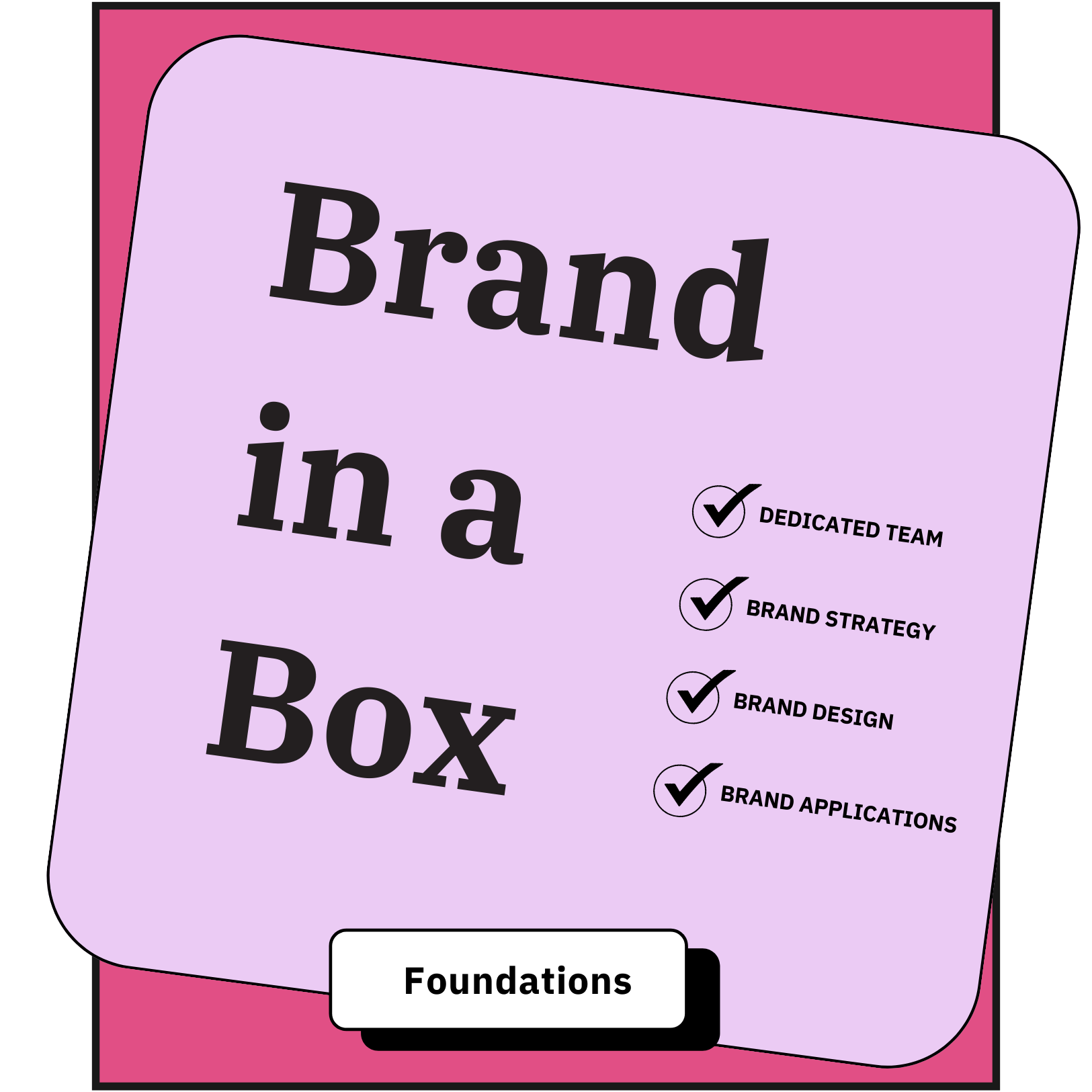Rebranding: The Ultimate Guide on How to Rebrand your Business in 2023
A Comprehensive Guide to Rebranding
Are you ready to take your brand to the next level?
If you're considering a rebrand, you're in the right place.
Rebranding is a strategic move that can help you stand out from the competition, attract new customers, and increase revenue.
At The Branded Agency, we've helped numerous companies achieve successful rebrands, from HumanCentric to Look Optometry to AromaTech.
Our expertise can be invaluable in guiding you through the rebranding process, ensuring that you achieve the results you want.
In this comprehensive guide to rebranding, we'll take you through the essential steps to building an effective rebranding strategy.
We'll explore the different types of rebranding, from a brand refresh to a complete brand overhaul, and help you decide which approach is right for your business.
We'll also delve into why companies rebrand and the benefits of rebranding.
A successful rebranding effort can lead to increased brand recognition, improved customer loyalty, and a boost in revenue.
But that's not all.
We'll also show you how to conduct market research, define your target audience, and develop a messaging and positioning strategy that aligns with your brand values and resonates with your customers.
Whether you're a startup looking to establish a strong brand identity or an established business seeking to revitalize your brand, this guide will provide you with the insights and tools you need to create a successful rebranding campaign.
So get ready to unleash your brand's full potential and take your business to the next level!
Rebranding Example: Burberry 2018
In 2018, the luxury fashion brand Burberry underwent a major rebranding effort, spearheaded by its then-CEO Marco Gobbetti and creative director Riccardo Tisci.
The goal was to modernize the brand and appeal to a younger, more diverse audience while still retaining its classic British heritage.
The first major change was to the Burberry logo, which had remained largely unchanged since the 1990s.
The new logo features a more minimalist, sans-serif font and drops the word "London" from the company name, reflecting Burberry's global reach.
The new logo was designed in collaboration with renowned graphic designer Peter Saville, who is best known for his work with Factory Records and Joy Division.
The second major change was to the brand's iconic trench coat.
While still retaining the classic design elements, such as the double-breasted front and belted waist, the new trench coats featured more modern details such as oversized lapels, shearling collars, and bold colors like bright red and mustard yellow.
Another significant change was the introduction of a new monogram print, which replaced the brand's previous check pattern.
The new monogram features interlocking T's and B's in shades of beige, white, and orange, and was designed by Riccardo Tisci in collaboration with British graphic designer Peter Saville.
The rebranding effort also included changes to Burberry's retail stores and digital presence.
The stores were updated with a more modern look, featuring sleek marble floors and brass fixtures, and the brand's website and social media channels were redesigned to better showcase the new brand identity.
Overall, the 2018 Burberry rebrand was a bold move to update and modernize the brand while still retaining its classic British heritage.
The new logo, monogram, and trench coat designs have been well-received by both fashion critics and consumers, and have helped to attract a new generation of customers to the iconic fashion house.
Content Navigation
Here are some very specific step by step branding guides for: Real Estate, Lawyers, Accounting, Doctors, Dentists, Optometrists, Jewellery, Makeup & Beauty, Skincare, Pet Food, Fashion and Construction.
What is Rebranding VS What is a Rebrand?
Rebranding is the process of changing your brand’s identity, which means adjusting everything from your logo to marketing strategies. Rebrands often come with a complete overhaul in terms of look, feel and even attitude.
On the other hand, rebranding can be considered more minor changes to an existing identity like refreshing an old logo or tweaking the tone of voice on website content.
Why Should I Rebrand?
Rebranding can help you to stay competitive in an ever-evolving market, as well as helping your business grow and reach a new audience.
A successfully implemented rebrand will also often result in increased customer trust and recognition – both key components for success.
Rebranding is ultimately an investment in your business that, when done right, could provide a return on investment for years to come.
Understanding Your Brand
Before you start any project, it’s essential to understand the core values of your brand.
Start by taking the time to reflect and ask yourself questions like:
- What is the purpose of my brand?
- Who are my ideal customers?
- How do I want them to feel when engaging with my business?
- What kind of values and beliefs does my brand stand for?
With that information in mind, you can begin creating a plan for your rebrand.
How to Rebrand a Product?
Rebranding a product often follows the same steps as rebranding an entire company, but with a few tweaks.
You’ll want to focus on understanding the needs of the target market for that particular product and creating messaging that resonates with them.
Additionally, you may want to consider ways to use digital marketing to reach your audience and promote the product.
Why do Companies Rebrand?
Rebranding can be a great way to stay ahead of the competition and expand your customer base by appealing to new customers.
It also allows you to differentiate yourself from competitors and refresh your image in the eyes of current customers, helping build loyalty and trust.
What are the Benefits of Rebranding?
• Increase visibility and appeal to new customers
• Differentiate from competitors
• Refresh existing brand image
• Build loyalty and trust with current customers
• Increase revenue
With the right strategy, rebranding can help your business gain traction in the market.
Do you need help with rebranding your business?
Checkout our “Brand in a Box” packages or small businesses
What are the Risks of Rebranding?
Obviously, there are risks involved with rebranding.
A poorly executed strategy can result in a misalignment of values and brand message, confusion among current customers, or even an unsuccessful launch.
It’s also important to consider the cost associated with a rebranding effort — both in terms of time and money.
Make sure you’re investing in a strategy that will be worth the effort and make sure it aligns with your long-term goals.
How do you Know if You Should Rebrand?
If you find yourself feeling stagnant or realize that your brand is no longer resonating with customers, then it may be time to consider rebranding.
Some other signs to look out for include an outdated logo or website design, a lack of engagement from customers on social media, and a general sense that your brand just isn’t as strong as it used to be.
Will Rebranding Alienate your Existing Clients?
No — in fact, rebranding can actually make your customers feel more connected to your business.
If you’re staying true to the values and messaging of your original brand, then a rebrand can help align those values with your current customer base.
The key is to ensure that you create a consistent message across all platforms.
This means that you should ensure your messaging, logo and visuals all remain the same throughout your website, social media accounts and any other marketing materials.
Will Rebranding Hurt my Companies Brand Recognition?
Not necessarily.
If you’re careful to maintain consistent messaging and visuals throughout your rebranding process, then it can actually help increase brand recognition by providing a cohesive look and feel across all platforms.
It’s also important to make sure that the new image of your company still aligns with the values that customers have come to expect from your business.
Is Rebranding a Good Business Strategy?
Yes! Rebranding is a great way to stay ahead of the competition and expand your customer base by appealing to new customers.
It also allows you to differentiate yourself from competitors and refresh your image in the eyes of current customers, helping build loyalty and trust.
By investing in a successful rebranding strategy, businesses can reap many rewards — from increased visibility and revenue to improved customer loyalty.
No matter what your goals are, rebranding can be a great way to give your business a much-needed boost and make sure it stands out from the crowd.
With the right strategy in place, rebranding can help you grow your business and achieve success.
But before you jump into a rebranding project, it’s important to consider the risks and make sure that you have a plan in place to ensure your success.
Planning is key — so be sure to take your time and get it right!
What Work does Rebranding Include?
A rebrand may include updating or changing your brand logo, color palette, typography, iconography, photography, patterns, illustrations, brand personality, various brand elements and visual elements, mission statement, vision, web design, marketing materials, uniforms and other aspects of your company identity.
How to Successfully Rebrand and Create a New Identity?
The key to a successful rebranding project is planning. You must do your research and make sure that you’re targeting the right audience with the right message.
This includes analyzing your current customer base, creating powerful visuals, crafting compelling copy, and choosing the right channels to market your new identity.
It’s also important to create a strategy that will tie everything together and ensure consistency across all of your platforms.
This includes creating content that is on-brand, actively engaging with customers on social media, and making sure that you’re investing in the right marketing channels for maximum reach.
Rebranding Strategy VS Brand Strategy
While rebranding and brand strategy are often used interchangeably, there’s a difference between the two.
Rebranding is more of a tactical approach to changing your existing identity, while brand strategy refers to the overall messaging and positioning of your brand.
For example, when you’re creating a rebranding strategy, you’re focusing on the look and feel of your brand.
On the other hand, a brand strategy focuses on building a cohesive narrative that will help establish trust with current customers and appeal to new ones.
The most successful rebranding efforts combine both elements — creating a visual identity that resonates with customers while also conveying a powerful message that speaks to the core values of your business.
How much Does Rebranding Cost?
The cost of rebranding will range from $10,000 - $35,000 for startups and small businesses.
The cost of rebranding for a medium to large company is $50,000 - $250,000 on average, depending on the scope of work.
Rebranding can be costly, with the cost varying depending on your business size and scope of the project.
On average, a comprehensive rebrand requires thousands of dollars to complete successfully.
For larger businesses such as CocaCola or Apple who are simply redesigning their logo may have to spend up to one million dollars due to marketing costs that come along with the rebrand process.
Are you ready to give your business a sleek, modern look?
Look no further than The Branded Agency.
Our full-service branding agency is designed for the next generation of businesses and offers everything from brand strategy to rebranding existing entities.
Make contact today if you're interested in getting an individualized quote tailored to all of your needs!
Let us show you how our tactics will bring life back into your company's image, with brand identity, marketing amplification, and more.
Rebranding can be a great investment for your business, but it’s important to take the time to consider all options carefully before taking the plunge.
With the right strategy, you can breathe new life into your brand and build customer loyalty in the process.
Fortunately, there are some ways to keep costs down.
Develop a clear strategy before starting your project and make sure you are utilizing existing resources (like existing logos) wherever possible.
Additionally, consider working with freelancers or agencies that specialize in branding to help you maximize the impact of your rebranding efforts.
Rebranding can be an intimidating process, but it doesn’t have to be!
Armed with the right information and strategy, you can transform your business into something new and exciting.
Is the Branding Process Different for Creating a New Brand VS a Rebrand of an Old Company?
The branding process for creating a new brand and rebranding an existing company are the same, but there are some key differences.
When creating a new brand, you have the luxury of starting from scratch and can focus on crafting an identity that is original and unique to your business.
When rebranding, you’re working with an existing brand identity, so you have to consider how to build off of what’s already in place.
That means taking the time to research and analyze your current brand voice and visuals, as well as considering any customer feedback or suggestions prior to rolling out a new look.
The bottom line?
No matter which type of branding project you’re working on, the process of creating a strong identity and building brand loyalty takes time and effort.
But with proper planning and strategy, you can make sure that your rebrand or new brand launch is successful!
New Logo Design VS Logo Redesign
When it comes to rebranding, one of the most important elements is logo design.
A logo is the cornerstone of any brand’s visual identity and helps customers form an immediate impression about your business.
If you’re creating a new brand, then you may opt for a completely new logo design that reflects your unique brand values and personality.
On the other hand, if you’re rebranding an existing business then a logo redesign may be the better option as it will help to update your current look while still maintaining some of the original elements that customers are familiar with.
No matter what type of logo design project you undertake, make sure you are working with a skilled designer who is familiar with industry trends and can create something that’s both visually appealing and reflects the essence of your brand.
Do you need to update your brand image with a new logo?
What do you do After Completing a Rebrand?
The first thing you should do is update your brand guidelines to ensure consistent usage of your new visual identity in all customer-facing materials.
Additionally, don’t forget to update any existing digital assets with the new logo, fonts and color palette.
Once you have updated your brand guidelines and visuals, it’s time to start amplifying your rebranding efforts and doing a rebrand launch.
Reach out to current customers to let them know about the changes you’ve made and use social media to spread the word.
Don’t forget to include visuals of your new logo, color palette and fonts in your promotional materials!
My Company Decided to Enter into a New Market, What is the Best Brand Strategy for Marketing Positioning?
When entering into a new market, it’s important to create an effective brand strategy that will help you stand out from the competition.
Your marketing positioning should be based on research and analysis of the target market, understanding their needs and wants and crafting a message that resonates with them.
For example, if your business is entering the health and wellness market, you might position your brand as a trusted source of advice for busy professionals.
Or if you’re entering the fashion industry, you could focus on creating an image of luxury, quality and exclusivity.
Your brand strategy should also include tactics for gaining visibility in the new market.
This could be anything from content marketing to influencer marketing, depending on your budget and the type of business you’re in.
Ultimately, it’s important to create a brand strategy that will help you stand out from the competition and establish yourself as an authority in your new market.
With the right combination of research, creative thinking and execution, you can make sure that your business succeeds in its new venture!
So, How do You Rebrand Your Business?
Source: Crazy Studios
What are the Rebranding Process and Steps?
Rebranding can seem daunting, but it doesn’t have to be! Here are some steps you can take to help ensure your rebranding efforts are successful:
1. Set realistic goals and objectives for the rebrand.
2. Understand why you are undertaking a rebrand.
3. Research your target market.
4. Brainstorm new ideas and create a visual identity.
5. Design marketing materials and develop an online presence.
6. Launch the rebrand and tell your story to the world!
7. Analyze results, refine strategy or adjust goals as needed.
Develop a Clear Vision & Goals:
Before you start any rebranding efforts, it’s important to clearly define the vision for your new brand and set measurable goals that will determine whether or not you’ve been successful. An effective rebrand will not only help you reach your goals but also communicate a clear message about who you are and what you stand for.
Research Your Audience:
To be successful, it’s critical to understand the needs of your target audience. Take the time to research who they are, what their interests are, and how they interact with your brand. This can help you create messaging that resonates and ensure you’re providing the best experience for them.
Get Creative:
It’s time to get creative! Brainstorm ways to update your branding, from the look of your logo, to the way you communicate with customers on social media or through email. Consider how you want to be perceived and make sure your efforts reflect that.
Test & Iterate:
Once you’ve created the new vision for your brand, test it out with a small sample of customers or employees and get their feedback. This will help you further refine the changes and ensure they’re making a positive impact.
Measure Your Success:
Rebranding is an ongoing process and success can take time to measure. Make sure you’re tracking key performance indicators (KPIs) such as customer engagement, sales, website traffic, etc. so you can monitor your progress and fine-tune your efforts as needed.
Hiring a Branding Agency for your Rebrand
To effectively rebrand, you need a rebranding strategy and it's highly recommended you hire a branding agency that has experience with rebranding businesses.
A good agency can help you create a strategy, design marketing materials and develop an online presence that reflects your new brand.
Rebranding isn’t easy, but it can be incredibly rewarding if done right. By taking the time to research your audience, get creative with your messaging, and measure the results of your efforts, you can help ensure that your rebrand is a success!
Examples of Successful Rebrands
A great way to get inspired is by looking at some of the most successful rebrands out there.
Here are a few examples:
• Apple – Apple’s 1997 “Think Different” campaign was considered one of the greatest rebranding efforts in history and helped turn Apple into a powerhouse brand.
• Starbucks – Starbucks rebranded in 2008 to emphasize the company’s commitment to sustainability, and has since seen huge success.
• McDonald's – In 2017, McDonald’s refreshed their iconic logo and marketing materials to give the brand a more modern feel.
These examples highlight the importance of research, creative thinking, and measuring results to ensure a successful rebrand.
Rebranding Startups and Small Businesses
The Branded Agency has done several rebrands for startups and small businesses of different sizes across a variety of different industries.
Some of our most successful rebrands include HumanCentric, Look Optometry and AromaTech.
Conclusion
To ensure a successful rebrand, it is recommended that one hires a professional branding agency for research, planning, strategy and to guide them through the entire process.
This will allow you to maintain customer loyalty while creating an identity that appeals both to current customers as well as newcomers alike.
With their expertise by your side, you can rest assured knowing that your company's rebranding efforts are in good hands!
Do you need a new website? First, read our blog post on the ultimate guide to "Website Design in Vancouver”
Checkout our Other Blog Posts
Other Resources
Branding in a Box for Small Businesses
Digital Marketing Report for 2023
The Ultimate Guide to Creating a Brand Identity
A Guide to Branding and Marketing for Accounting Firms





















